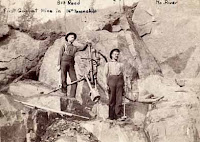 On Sunday June 7 and Sunday June 14, specially researched and custom designed Dutch concerts will be performed by two different musicians groups at the First Presbyterian Church at 38 Broadway in the city of Rensselaer at 3pm. The public is invited to take part and enjoy one very high style concert and, in contrast, one concert for the common folk. The concerts will benefit the Crailo Historic Site.
On Sunday June 7 and Sunday June 14, specially researched and custom designed Dutch concerts will be performed by two different musicians groups at the First Presbyterian Church at 38 Broadway in the city of Rensselaer at 3pm. The public is invited to take part and enjoy one very high style concert and, in contrast, one concert for the common folk. The concerts will benefit the Crailo Historic Site.
The first on Sunday June 7 features classical Dutch music of the Golden Age. Musicians of Ma’alwyck perform this Dutch repertoire on clavichord, traverso flute, cello, and violin-instruments popular in the first half of the seventeenth century. Director of Musicians of Ma’alwyck, music historian and virtuoso, Ann-Marie Barker Schwartz has researched and arranged a program fit for the Dutch wealthy middle
and upper classes of the first half of the seventeenth century. The popular regional musical group researched documents at Yale and in the Netherlands in order to present this concert.
The Bells and Motley Consort of Olden Music presents the second concert steeped in seventeenth folk tradition from the Netherlands and Flanders which will be held on Sunday June 14. John and Sondra Bromka, the musical couple that make up this distinctive group, have lived in the Dutch and Belgian countryside studying and teaching music of an earlier time. The instruments used in all of Bells and Motley’s performances are antique or created as authentic reproductions of early musical instruments. John has made many of the instruments himself and audience
members will be introduced to a different look and sound of music–a look and sound enjoyed by the common person of Holland and Flanders in the 1600s.
Gauging from the multitude of paintings depicting Netherlandish culture, music and dance was an important part of life in the late sixteenth and seventeenth centuries, from rollicking village peasants on upwards. In truth, no part of Europe offers better documentation of the arts of musical pastime than the Netherlands during these years, thanks to the skilled and ambitious painters, musical publishers, and composers of this region. Artists’ images leave such a rich legacy of vivid musical scenes that we can almost hear the paintings come to life, be it a village celebration with festive bagpipes, or an intimate indoor scene including the gentle lute.
Crailo State Historic Site will add ambiance to the musical events by offering images of select Dutch paintings and staff members in historic costume.
These concerts are offered as a historic musical experience and to help ring in the Quadricentennial Commemoration and the upcoming permanent exhibit debut of A Sweet and Alien Land: Colony of the Dutch in the Hudson River Valley at Crailo State Historic Site on July 4 and 5 from 11am to 5pm.
Both concerts will be held at 3pm at the First Presbyterian Church at 38 Broadway just a block north of Crailo. Concert goers are invited to the lawns at Crailo following the concert for a reception of Dutch and Flemish cheeses, mustards and pretzels. Drinks will also be served. We plan to offer a sneak preview of Crailo’s very special Marketplace Museum Shop during the receptions.
Tickets are $22.50 per person per concert or just $17.50 per person per concert if purchasing the series. Child tickets are $12.00 each. Checks may be made out to Friends of Fort Crailo and receipt of your check secures your place at the concert or concerts. Checks may be mailed to Friends of Fort Crailo, 9 ? Riverside Avenue, Rensselaer, NY 12144. For more information please contact Crailo at 518-463-8738.
Friends of Fort Crailo is a not-for-profit educational organization that supports the research and interpretive projects at Crailo State Historic Site. Crailo State Historic Site is one of 35 state historic sites and 176 state parks administered by the New York State Office of Parks, Recreation, and Historic Preservation. For further information about New York State Parks and Historic Sites, go to www.nysparks.com.






